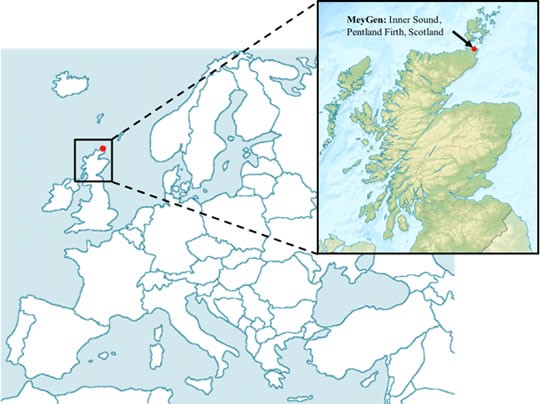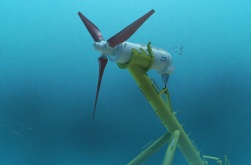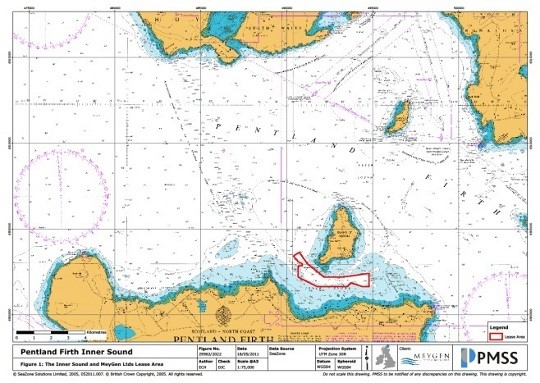Construction about to start on the world's first tidal turbine farm off northern Scotland
The tides move unimaginable quantities of water through the Pentland Firth four times a day. With speeds that can reach 5 metres a second (11 miles an hour) and relatively shallow waters, the narrow channel between Scotland and the Orkney Islands is probably the best place in the world to install underwater turbines. Best, that is, in terms of available energy. Worst, on the other hand, in terms of the mechanical stresses on a seafloor rotating machine.

Construction work will begin here early next year on one of the world’s first multi-machine installations to turn that energy into electricity. The turbines will go onto the sea bed in early 2016 and electricity will start to flow. The money is finally raised for the MeyGen project, the technology chosen, permits granted and the infrastructure planning is done.
£51m of capital will put four 1.5 MW turbines onto the sea bed, three or four times the cost of an equivalent amount of offshore wind. This is a hugely costly experiment but, as Dan Pearson the CEO of MeyGen points out, this seed money is nothing compared to the expense of a large tidal lagoon or other highly promising, but unproven, energy technologies.
The attractions of the Pentland Firth have been obvious for a decade or more and under-researched claims have been made for the potential. I think I remember suggesting in a book of 2008 that it might provide enough electricity to power London. As time has gone on, the difficulties of exploiting the tides have become clearer and calmer souls have begun to introduce some reality. It looks as though 1 or 2 gigawatts might eventually be extracted from this stretch of sea. The tides don’t flow all the time and a tidal turbine will deliver approximately the same capacity factor (40%) as an offshore turbine. This implies the Pentland Firth might deliver a couple of percent of UK electricity supply. Not quite London’s requirements - more like Oxfordshire’s - but still worthwhile. And there are many other locations, including around the Channel Islands, where tidal flows are fast and widespread.
The MeyGen plan is eventually to put almost 400 MW of machinery in to this part of the Pentland Firth.
The patch of sea for which it has a licence has relatively shallow, but not too shallow, water and a gradual incline up to shore. The substation and other infrastructure will be on flat land near to the sea. It will take until the early part of the next decade for enough grid capacity to be provided for the larger part of this project. So even if this early 6 MW experiment is wildly successful, we’ll only see a gradual rollout of turbines over the period to 2022.
The developer is using turbines from Hammerfest, a Norwegian company that has had machines in development for almost two decades. Why Hammerfest, I asked? Because of the rugged reliability said Dan Pearson of MeyGen. ‘Every system in the turbine is replicated three times’, meaning that the developer doesn’t have to keep fishing turbines out of the water to replace failed parts. Fans of the graceful and sleek modern wind turbine will be disappointed by the Hammerfest machine. If wind turbines are ballet dancers, tidal turbines are night club bouncers. But consider the enormous forces that will buffet the underwater machines, and I think we’d all prefer squat and burly types under the waves. After all, water is almost a thousand times heavier than air.
It is an unfair question, but I asked Dan Pearson why investors and governments should back Meygen when tidal current projects seem to be so expensive at the moment. Pearson said he hoped to bring the cost per megawatt down by 70% over the period of construction of the full 400 MW project. Hammerfest Strom’s costs will fall as it starts to construct multiple turbines and MeyGen gets better at digging in the holes in the sea floor needed to anchor the turbines. There are also economies of scale in the shore infrastructure, meaning that the second half of the project will be much cheaper than the first.
Will MeyGen get tidal turbine costs below offshore wind, usually seen as the most expensive low carbon technology that the UK and Scottish governments will support? Pearson was understandably a little cagey. It’s far too early to tell how costs will fall. But he recognised that if doesn’t become financially competitive even the utter reliability of tidal power isn’t going to be enough to ensure private investment.
The current 6 MW project will deliver about 20 GWh a year, if the company’s projections are correct. The output earns 5 ROCs, or about £250,000 a GWh and is pre-sold to Smartest Energy under a power purchase agreement, probably for about an additional £50,000 or so per GWh. If things go to plan, this means yearly revenue will be approximately £6m. Even though about a quarter of the £51m development cost has been given in grants from UK government bodies, the finances of this experiment aren’t overwhelmingly attractive. As we all know, few underdeveloped technologies that will move us to a low carbon circular economy are.
At completion, MeyGen will put 400 MW of tidal turbines in a space that would only accommodate 40 MW of wind. When I give talks, I’m always asked about whether the UK can physically accommodate all the sources of low-carbon energy it needs. (Of course this problem would be become irrelevant if we could find a way of exploiting nuclear energy cost effectively). Tidal current systems, and their distant relation tidal lagoons, help us because they use little onshore land.
There are many unknowns still. Dan Pearson admits that we cannot accurately predict how densely we will eventually be able to pack turbines in the tidal races between Scotland and the northern isles. But this is quibbling. The UK has access to more fast flowing tidal races than any other country and it must make sense to invest in trying to see whether it can be exploited cost effectively, and then exported to Canada, Chile, China and other countries with strong tidal flows.
We know that wind turbines have declined in cost by a factor of at least five in the last thirty years and progress might well be as rapid with their underwater cousins. At that lower price, they can compete with offshore wind as well as having the major advantage of predictable, reliable output. MeyGen is one of the most exciting projects in the UK today and we should salute its owners, the first group to get all the pieces in place to exploit one of the world’s densest sources of renewable energy.

